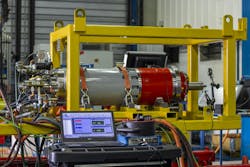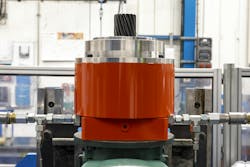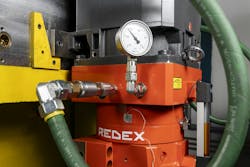Why Rack and Pinion Drives Are Key to Next-Gen Multitasking Machines
As machine tools advance to combine turning, milling, and drilling in a single setup, designers face a rising challenge: Heat. Higher speeds and torque improve productivity but generate thermal stress that dampens machining accuracy. French drive specialist REDEX is answering that challenge with cooling-optimized rack and pinion systems designed for multitasking machines.
The Thermal Barrier to Productivity
Modern multitasking machines combine turning, milling, and drilling into one setup, increasing throughput and precision. On the flip side, that increased throughput leads to more energy and motion within a single machine, generating heat beyond the limits of a normal drive system, along with thermal drift, which leads to distorted parts and reduced repeatability.
Instead of adding more insulation or changing tolerances, REDEX is rethinking the drive system altogether.
Rethinking the Drive: Why Rack & Pinion Wins
When it comes to linear motion in machine tools, design engineers typically choose between linear motors, ball screws, or rack & pinion systems. Each has its trade-offs:
- Linear motors are great for speed and precision, but can be costly due to magnets, cooling gear, and high power consumption.
- Ball screws, while common, are prone to thermal expansion under high loads, affecting accuracy over time.
- Rack & pinion drives, especially those with cooling capabilities, strike a balance, offering stiffness, unlimited travel, and better thermal control.
REDEX has taken an approach that focuses on rack & pinion systems that integrate cooling to manage heat directly at the source.
Cooling-First Engineering
REDEX has a long history of thermal innovation, including pioneering water-cooled gearboxes for high-speed spindles more than 40 years ago. That experience feeds into its current RP series of planetary gearboxes, which offer two levels of cooling:
- Standard Cooling: An internal oil circulation system that's paired with oil & air or oil & water exchangers. Cooling ports are included in both rack & pinion components.
- Optional Cooling Jacket: For applications with extreme thermal loads, add-on jackets increase cooling efficiency. However, these jackets also increase the size and cost of the gearbox.
Backed by a digital twin-based modeling system that simulates thermal behavior, machine builders and designers can easily predict heat dissipation and choose the best configuration before installation.
Testing and Real-World Validation
REDEX validates its systems through in-house testing, measuring gearbox temperatures under load and verifying nominal ratings. During testing, a historical gearbox design achieved a temperature delta of 10°C lower than the spindle and motor, even at 12,000 rpm.
Making Multitasking Machines More Precise
For machine builders targeting the growing market for multitasking centers, thermal control is no longer a side consideration—it's fundamental. By designing cooling into the drive system from the ground up, REDEX offers a way to maintain accuracy, extend component life, and enable higher speeds without compromise.
Learn more about REDEX’s RP series and thermal modeling tools at redex-group.com.
About the Author
Laura Davis
Editor-in-Chief, New Equipment Digest
Laura Davis is the editor in chief of New Equipment Digest (NED), a brand part of the Manufacturing Group at EndeavorB2B. NED covers all products, equipment, solutions, and technology related to the broad scope of manufacturing, from mops and buckets to robots and automation. Laura has been a manufacturing product writer for eight years, knowledgeable about the ins and outs of the industry, along with what readers are looking for when wanting to learn about the latest products on the market.



